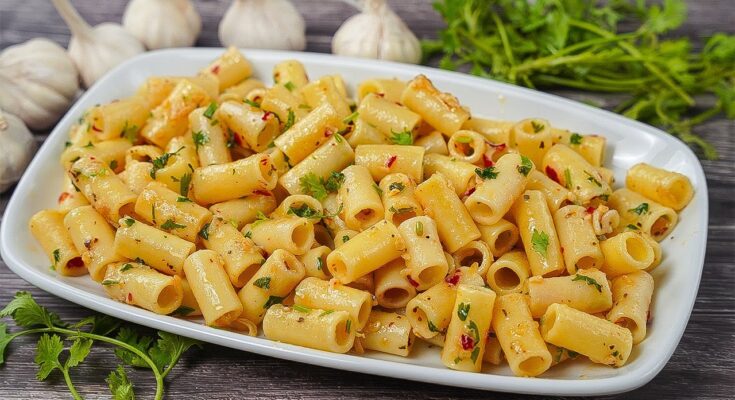Garlic Pasta Recipe: Pasta is one of those meals that never fails to bring comfort to the table. Among all the varieties, garlic pasta stands out because it’s rich, aromatic, and unbelievably simple. With just a handful of ingredients, you can prepare a dish that feels both fancy and homely at the same time. Whether you’re cooking for yourself after a long day or making dinner for loved ones, garlic pasta is always a hit.
This guide will take you through everything you need to know—from ingredients and preparation to a full step-by-step process. By the end, you’ll be able to whip up a restaurant-quality garlic pasta right in your own kitchen.
Introduction to Garlic Pasta
Garlic pasta is the kind of dish that proves the phrase “less is more.” It relies on a short list of ingredients—garlic, pasta, oil, and seasonings—but creates bold, unforgettable flavors. What makes it so appealing is the balance: the nutty richness of garlic sautéed in olive oil, the soft chewiness of pasta, and just the right sprinkle of herbs and cheese to bring everything together.
This recipe is popular not only in Italy, where pasta is a staple, but also in kitchens around the world. The reason is simple: garlic pasta adapts easily to personal tastes. You can keep it basic and light for a quick meal or elevate it with extras like cream, shrimp, or vegetables when you want something more indulgent.
Another reason people adore garlic pasta is its versatility. It works equally well as a main dish or a side. Pair it with grilled chicken, serve it alongside roasted vegetables, or simply enjoy it on its own with a glass of wine.
If you’re someone who usually thinks of pasta as time-consuming or complicated, you’ll be surprised. Garlic pasta can be ready in under 30 minutes, making it the perfect balance between convenience and elegance.
Ingredients You’ll Need
Before diving into the cooking process, it’s essential to gather all your ingredients. The beauty of garlic pasta is that it doesn’t require an endless shopping list. Most of what you need might already be sitting in your pantry.
Core Ingredients
These are the essentials that form the backbone of garlic pasta:
- Pasta (spaghetti, linguine, or fettuccine work best)
- Garlic cloves (fresh and finely sliced or minced)
- Olive oil (extra virgin preferred for flavor)
- Salt (to season the pasta water and sauce)
- Black pepper (freshly ground gives the best taste)
- Parmesan cheese (grated, for finishing)
Optional Add-ons for Extra Flavor
Want to make your garlic pasta richer or more unique? Consider adding:
- Crushed red pepper flakes (for a spicy kick)
- Fresh herbs like parsley or basil
- Lemon zest or juice for brightness
- Butter for creaminess
- Vegetables such as spinach, cherry tomatoes, or mushrooms
- Protein like shrimp, chicken, or bacon
Substitutes for Special Diets
Don’t worry if you’re following a specific diet—garlic pasta can be adapted easily.
- Gluten-free pasta works well as a replacement.
- Vegan diets can skip Parmesan or use nutritional yeast instead.
- Low-carb eaters can substitute pasta with zucchini noodles or spaghetti squash.
By understanding these ingredient options, you can make your garlic pasta your own—whether you want to keep it classic or give it a twist.
Kitchen Tools and Preparation Tips
Cooking garlic pasta doesn’t require fancy equipment, but having the right tools will make the process smoother and more enjoyable.
Essential Cooking Tools
- A large pot for boiling pasta
- A colander to drain pasta efficiently
- A large skillet or pan for preparing the garlic sauce
- A wooden spoon or spatula for stirring
- A sharp knife for finely slicing garlic
- A grater for Parmesan cheese
Prepping Ingredients for Efficiency
One secret to stress-free cooking is preparation. Chop your garlic before you even start boiling water. Measure out your oil, grate your cheese, and have herbs ready. This way, when it’s time to combine everything, you won’t be scrambling around the kitchen.
Also, don’t underestimate the importance of pasta water. When draining your pasta, always save at least a cup of the starchy water. This liquid gold is the secret to binding the sauce and pasta together, giving it that silky restaurant-like finish.
Tips for Perfect Pasta Every Time
- Always use plenty of water when boiling pasta—this prevents sticking.
- Salt the water generously; it should taste like the sea. This is the first layer of flavor.
- Cook pasta al dente, meaning firm to the bite. Overcooked pasta will ruin the texture.
- Toss the pasta in the sauce right away; don’t let it sit and clump together.
By following these prep tips, you’ll set yourself up for success before even turning on the stove.
Step-by-Step Guide to Making Garlic Pasta
Now comes the exciting part—the actual cooking. This step-by-step guide ensures that you’ll achieve a dish that’s both flavorful and satisfying, even if you’re new to cooking.
Step 1 – Boiling the Pasta
Fill a large pot with water, add a generous amount of salt, and bring it to a boil. Add your chosen pasta and cook according to package directions, usually around 8–10 minutes. Remember, aim for al dente. Once done, drain but keep a cup of pasta water aside—you’ll need it later.
Step 2 – Preparing the Garlic Base
While the pasta cooks, heat olive oil in a skillet over medium heat. Add sliced garlic and let it cook gently until golden and fragrant. Be careful not to burn it—burnt garlic tastes bitter and will ruin your sauce. If you’re adding extras like chili flakes or butter, this is the time to mix them in.
Step 3 – Combining Pasta with Sauce
Transfer the drained pasta directly into the skillet with the garlic oil. Toss it well, adding small amounts of reserved pasta water until the sauce clings perfectly to the noodles. The starchy water helps emulsify the oil, creating a smooth coating.
Step 4 – Adding Final Touches
Turn off the heat and sprinkle freshly grated Parmesan and chopped parsley on top. Add a final crack of black pepper and, if desired, a squeeze of lemon juice for brightness. Your garlic pasta is now ready to serve hot and fresh.
Serving Suggestions and Pairings
Garlic pasta is versatile, which means it can be the star of the show or a supporting player alongside other dishes. How you serve it really depends on the occasion. Let’s break down some delicious ways to elevate your garlic pasta experience.
Best Sides to Serve with Garlic Pasta
When garlic pasta takes center stage, you’ll want sides that complement rather than overpower its flavor. Here are some great options:
- Garlic bread – Yes, more garlic! Crispy on the outside and soft on the inside, it pairs perfectly with pasta.
- Roasted vegetables – Think zucchini, bell peppers, or asparagus. Their caramelized flavors add freshness.
- Salads – A light green salad with vinaigrette balances the richness of the pasta. Caesar salad is also a classic match.
- Soup starters – Tomato basil soup or a light vegetable broth makes for a comforting combination.
Wine and Beverage Pairings
A good drink can elevate your pasta dinner into a restaurant-like experience.
- White wine like Pinot Grigio or Sauvignon Blanc complements the garlicky, slightly oily base of the pasta.
- Red wine lovers can opt for a light-bodied red such as Chianti.
- Non-alcoholic options like sparkling water with lemon or iced herbal tea also pair well, refreshing the palate between bites.
Garnishing Ideas
Never underestimate the power of a garnish. Simple toppings can make your garlic pasta look and taste even better.
- Freshly chopped parsley for color and freshness.
- Extra Parmesan or Pecorino Romano for richness.
- A drizzle of extra virgin olive oil for aroma.
- A light sprinkle of red pepper flakes for a subtle kick.
The right garnish and pairing can take your humble garlic pasta from everyday meal to an impressive dinner centerpiece.
Health Benefits of Garlic Pasta
Garlic pasta isn’t just delicious—it can also be surprisingly good for you. Of course, it depends on how you prepare it, but when done right, this dish has several benefits.
Nutritional Value of Garlic
Garlic has been prized for centuries, not just as a flavor booster but also for its medicinal properties. It contains compounds like allicin, which is known to support heart health, boost immunity, and even help reduce cholesterol levels. Adding garlic regularly to your diet is like giving your body a natural health supplement.
Olive Oil and Heart Health
Most garlic pasta recipes use olive oil as a base, and that’s a huge plus. Olive oil is rich in monounsaturated fats, which are linked to improved heart health. It’s also packed with antioxidants that help fight inflammation. Compared to heavy cream-based pasta dishes, garlic pasta is a lighter, healthier option.
Balanced Energy from Pasta
Pasta itself often gets a bad reputation, but when eaten in moderation, it’s an excellent source of carbohydrates—your body’s main source of energy. Whole wheat or gluten-free pasta options can add fiber and additional nutrients, making the dish even healthier.
By keeping portions balanced and adding vegetables, garlic pasta can be both satisfying and nourishing, proving that comfort food doesn’t always have to be unhealthy.
Common Mistakes to Avoid
Even though garlic pasta seems straightforward, a few mistakes can ruin the dish. Here’s what to watch out for:
Burning the Garlic
The number one mistake! Garlic cooks quickly, and once it turns too dark, it becomes bitter. Always cook it on medium heat and remove it from the stove once it’s golden.
Overcooking the Pasta
Mushy pasta won’t hold up well to the sauce. Always check a minute before the suggested cooking time on the package. Aim for that perfect al dente bite.
Using Too Little Salt in Water
Salted pasta water is the foundation of flavor. If you skimp on salt, the entire dish can taste bland, no matter how much garlic or cheese you add later.
Skipping the Pasta Water
That starchy water you save before draining? It’s not optional. It helps create a silky sauce that clings to the pasta. Without it, your dish may feel dry and disconnected.
By avoiding these common errors, you’ll ensure that your garlic pasta tastes just as good as (or even better than) your favorite Italian restaurant’s version.
Variations of Garlic Pasta
Garlic pasta is like a blank canvas—you can make it your own with just a few tweaks. Let’s explore some delicious variations.
Creamy Garlic Pasta
For those who love indulgence, adding cream or a mixture of cream and butter creates a velvety texture. This version pairs beautifully with chicken or mushrooms.
Spicy Garlic Pasta (Aglio e Olio Style)
Classic Italian-style aglio e olio is garlic pasta with olive oil and a kick of red pepper flakes. It’s bold, spicy, and incredibly simple.
Garlic Shrimp Pasta
Seafood lovers can sauté shrimp with garlic before tossing it into the pasta. The natural sweetness of shrimp balances perfectly with the garlicky oil.
Vegetable Garlic Pasta
For a lighter, more wholesome version, add roasted or sautéed vegetables like broccoli, zucchini, or spinach. This makes the dish more colorful and nutritious.
Vegan Garlic Pasta
Skip the Parmesan and add nutritional yeast instead. Pair with vegan butter or olive oil for a fully plant-based dish that still feels indulgent.
These variations prove that garlic pasta isn’t just one recipe—it’s a whole family of possibilities.
How to Store and Reheat Garlic Pasta
One of the best things about garlic pasta is that it makes delicious leftovers. But if you want it to taste as fresh as when you first cooked it, you’ll need to store and reheat it the right way.
Storing Garlic Pasta
- Refrigerator: Place cooled garlic pasta in an airtight container and store it in the fridge. It will stay fresh for up to 3–4 days.
- Freezer: For longer storage, you can freeze garlic pasta. Put it in a freezer-safe container or bag, removing as much air as possible. It will last for about 1–2 months.
Reheating Garlic Pasta
- Stovetop Method (Best Option): Heat a skillet, add a little olive oil or butter, and toss the pasta until warmed through. Add a splash of water or broth if it feels dry.
- Microwave Method: Place the pasta in a microwave-safe dish, cover it with a damp paper towel, and heat in 1-minute intervals, stirring in between.
- Oven Method: Preheat your oven to 350°F (175°C). Place pasta in an oven-safe dish, cover with foil, and bake for about 15–20 minutes.
Tip: When reheating, avoid overcooking or drying out the pasta. Always add a little moisture—pasta water, broth, or even a drizzle of olive oil—to bring it back to life.
Tips for Cooking Garlic Without Burning
Garlic is the star of this dish, but it’s also the trickiest ingredient. Burnt garlic can ruin your pasta with its bitter taste, so here’s how to avoid that common pitfall.
Control the Heat
Always cook garlic on medium or low heat. High heat causes it to brown too quickly and lose its sweet, nutty flavor.
Timing Matters
Add garlic to the oil only once it’s warm, not smoking hot. If the oil is too hot, garlic will scorch instantly.
Cut Size and Shape
- Thin slices cook slower than minced garlic, so they’re less likely to burn.
- Minced garlic, while flavorful, needs extra care—stir continuously and remove from heat at the first sign of golden color.
Use Butter and Oil Together
Mixing butter with oil helps stabilize the cooking temperature, giving you more control and reducing the risk of burning.
With these simple tips, you’ll be able to bring out garlic’s best flavors—sweet, aromatic, and slightly nutty—without any unpleasant bitterness.
Garlic Pasta for Special Diets
Garlic pasta is adaptable, making it perfect for people with specific dietary needs. You don’t have to give up flavor just because you’re following a certain diet plan.
Gluten-Free Option
Use gluten-free pasta made from rice, corn, or chickpeas. These options cook quickly and pair well with garlic and oil-based sauces.
Low-Carb/Keto-Friendly Version
Swap traditional pasta for zucchini noodles (zoodles), spaghetti squash, or shirataki noodles. These keep the carb count low while still giving you the satisfaction of a pasta-like dish.
Vegan Garlic Pasta
Replace Parmesan cheese with nutritional yeast or a vegan cheese alternative. Use plant-based butter if you want a creamy version without dairy.
Dairy-Free Option
If you’re lactose-intolerant, skip the cheese or substitute with lactose-free cheese. Olive oil alone provides enough richness to make the pasta satisfying.
By adjusting a few ingredients, you can make garlic pasta fit nearly any diet while keeping its authentic, comforting taste.
Why This Garlic Pasta Recipe Works
What makes this recipe stand out from the dozens of garlic pasta recipes online? It’s the balance of simplicity and depth.
- Minimal Ingredients, Maximum Flavor – The dish relies on garlic and olive oil, proving that you don’t need a long ingredient list for great taste.
- Quick and Easy – In under 30 minutes, you can create a meal that feels gourmet without spending hours in the kitchen.
- Customizable – Whether you want creamy, spicy, vegan, or loaded with protein, the base recipe adapts easily.
- Comfort Food with Health Benefits – Garlic, olive oil, and pasta combine to give you both satisfaction and nutrition.
- Foolproof Technique – The step-by-step process ensures beginners won’t feel overwhelmed, while experienced cooks can add their own flair.
This is the kind of recipe you’ll want to bookmark, not just because it’s easy, but because it can become a staple in your meal rotation.
FAQs about Garlic Pasta Recipe
1. Can I use pre-minced garlic instead of fresh cloves?
Yes, but fresh garlic gives the best flavor. Pre-minced garlic from jars can taste dull or slightly sour.
2. What pasta shape works best for garlic pasta?
Spaghetti and linguine are classics, but penne, fettuccine, or even angel hair also work beautifully.
3. How do I make garlic pasta less oily?
Use less olive oil and add a splash of pasta water to keep it light without losing flavor.
4. Can I add cream to this garlic pasta recipe?
Absolutely! For a creamy garlic pasta, stir in heavy cream or half-and-half right before combining with pasta.
5. How do I make garlic pasta kid-friendly?
Skip the chili flakes and keep the flavors mild. You can also add vegetables or chicken for a more balanced meal.
Conclusion
Garlic pasta is proof that the simplest recipes are often the best. With just a few pantry staples, you can whip up a dish that’s comforting, flavorful, and versatile. Whether you keep it classic with just garlic and olive oil or dress it up with shrimp, vegetables, or cream, garlic pasta never disappoints.
It’s easy enough for weeknight dinners yet elegant enough for hosting guests. And the best part? Once you master the basics, the possibilities are endless.
So next time you’re craving a meal that’s fast, satisfying, and packed with flavor, skip the takeout menu and try this garlic pasta recipe instead—you’ll thank yourself after the first bite.



